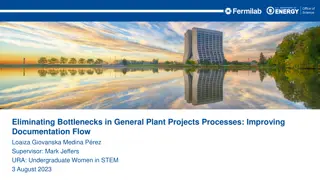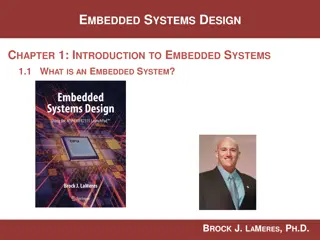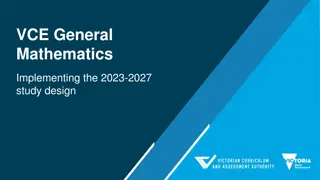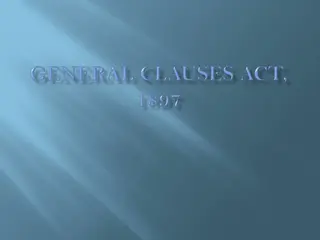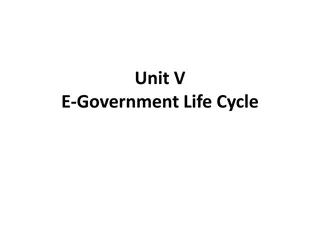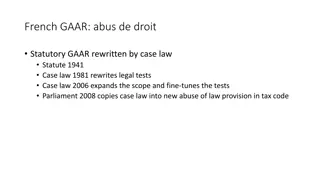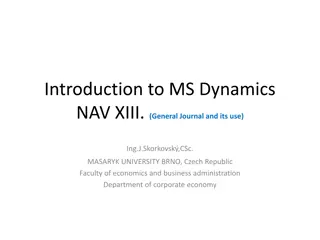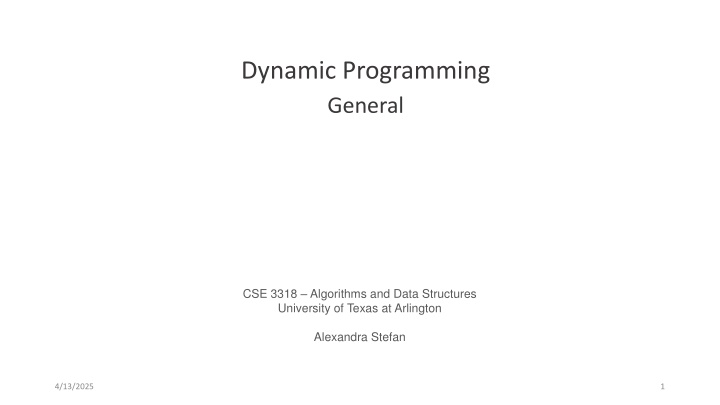
Approaches for Solving Dynamic Programming Problems
Learn about different approaches for solving dynamic programming problems, including greedy algorithms, dynamic programming, brute force methods, iterative and memoized solutions, and more. Understand the concepts of optimal substructure and overlapping subproblems in dynamic programming. Discover how iterative or bottom-up dynamic programming is a common solution technique.
Download Presentation

Please find below an Image/Link to download the presentation.
The content on the website is provided AS IS for your information and personal use only. It may not be sold, licensed, or shared on other websites without obtaining consent from the author. If you encounter any issues during the download, it is possible that the publisher has removed the file from their server.
You are allowed to download the files provided on this website for personal or commercial use, subject to the condition that they are used lawfully. All files are the property of their respective owners.
The content on the website is provided AS IS for your information and personal use only. It may not be sold, licensed, or shared on other websites without obtaining consent from the author.
E N D
Presentation Transcript
Dynamic Programming General CSE 3318 Algorithms and Data Structures University of Texas at Arlington Alexandra Stefan 4/13/2025 1
Approaches for solving DP Problems Greedy - typically not optimal solution (for DP-type problems) - Build solution - Use a criterion for picking - Commit to a choice and do not look back DP - Optimal solution - Write math function, sol, that captures the dependency of solution to current pb on solutions to smaller problems - Can be implemented in any of the following: iterative, memoized, recursive Brute Force - Optimal solution - Produce all possible combinations, [check if valid], and keep the best. - Time: exponential - Space: depends on implementation - It may be hard to generate all possible combinations Iterative (bottom-up) - BEST - Optimal solution - sol is an array (1D or 2D). Size: N+1 - Fill in sol from 0 to N - Time: polynomial (or pseudo- polynomial for some problems) - Space: polynomial (or pseudo- polynomial - To recover the choices that gave the optimal answer, must backtrace => must keep picked array (1D or 2D). Memoized - Optimal solution - Combines recursion and usage of sol array. - sol is an array (1D or 2D) - Fill in sol from 0 to n - Time: same as iterative version (typically) - Space: same as iterative version (typically) + space for frame stack. (Frame stack depth is typically smaller than the size of the sol array) Recursive - Optimal solution - Time: exponential (typically) => - DO NOT USE - Space: depends on implementation (code). E.g. store all combinations, or generate, evaluate on the fly and keep best seen so far. - Easy to code given math function Improve space usage - Improves the iterative solution - Saves space - If used, cannot recover the choices (gives the optimal value, but not the choices) DP can solve: - some type of counting problems (e.g. stair climbing) - some type of optimization problems (e.g. Knapsack) - some type of recursively defined pbs (e.g. Fibonacci) SOME DP solutions have pseudo polynomial time
Dynamic Programming (DP) - CLRS Dynamic programming (DP) applies when a problem has both of these properties: 1. Optimal substructure: optimal solutions to a problem incorporate optimal solutions to related subproblems, which we may solve independently . 2. Overlapping subproblems: a recursive algorithm revisits the same problem repeatedly . Dynamic programming is typically used to: Solve optimization problems that have the above properties. Solve counting problems e.g. Stair Climbing or Matrix Traversal. Speed up existing recursive implementations of problems that have overlapping subproblems (property 2) e.g. Fibonacci. Compare dynamic programming with divide and conquer. 3
Iterative or Bottom-Up Dynamic Programming Main type of solution for DP problems We can define the problems size and solve problems from size 0 going up to the size we need. Iterative because it uses a loop Bottom-up because you solve problems from the bottom (the smallest problem size) up to the original problem size. 4
Bottom-Up vs. Top Down There are two versions of dynamic programming. Bottom-up. Top-down (or memoization). Bottom-up: Iterative, solves problems in sequence, from smaller to bigger. Top-down: Recursive, start from the larger problem, solve smaller problems as needed. For any problem that we solve, store the solution, so we never have to compute the same solution twice. This approach is also called memoization. 5
Top-Down Dynamic Programming ( Memoization ) Maintain an array/table where solutions to problems can be saved. To solve a problem P: See if the solution has already been stored in the array. If yes, return the solution. Else: Issue recursive calls to solve whatever smaller problems we need to solve. Using those solutions obtain the solution to problem P. Store the solution in the solutions array. Return the solution. 6
Steps for iterative (bottom up) solution 1. Identify trivial problems 1. typically where the size is 0 Look at the last step/choice in an optimal solution: 1. Assuming an optimal solution, what is the last action in completing it? 2. Are there more than one options for that last action? 3. If you consider each action, what is the smaller problem that you would combine with that last action? 1. Assume that you have the optimal answer to that smaller problem. 4. Generate all these solutions 5. Compute the value (gain or cost) for each of these solutions. 6. Keep the optimal one (max or min based on problem) Make a 1D or 2D array and start feeling in answers from smallest to largest problems. Other types of solutions: 1. Brute force solution 2. Recursive solution (most likely exponential and inefficient) 3. Memoized solution 2. 3. 7

